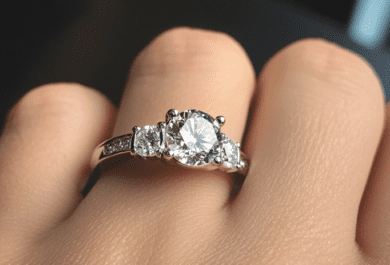AGSL
In 9 out of 16 cases, diamonds with AGSL reports were better deals for buyers, mainly as a result of stricter clarity grades. The average price difference for these 9 stones was 12%. However the average price for all 16 AGSL graded diamonds was 1% more when compared to the prices of the GIA-GTL graded stones because of the large price difference for stones # 6 and # 14.
It is most common for diamonds submitted to AGSL to be of or close to AGS 0. Diamonds graded with AGS ‘ideal’ proportions, polish and symmetry (stones # 5 to # 10) can have a premium of about 8% – 10% over the same grade GIA-GTL diamonds (e.g. stone # 9). Because of this premium diamonds with a softer AGSL grading (e.g. stone # 14) would be unfavorable buys. However, diamonds such as # 1 are good deals with AGSL reports because of stricter clarity grading.
In the past a myth has spread that GIA-GTL and AGSL exchange information, so that both labs give the same grade. Stones # 1 and # 2 both had laser inscriptions noting GIA registry numbers. AGSL noted the laser inscription numbers on its reports and in one case assigned a stricter clarity grade; in this case the myth of collusion is clearly just a myth.
EGL USA
Except for stone, # 14, which received a softer grade from both AGSL and EGL USA, buying a diamond based on an EGL USA report would have cost less (or the same in one case) than buying the same diamond with its GIA-GTL report. The market discounts EGL USA graded stones 10% more than the increased prices that result from often softer color grading. This buyer’s advantage holds when there is a small price difference for one grade of color or one grade of clarity. There were savings of about 20% for 5 out of 17 stones; their EGL USA grades matched or were stricter than GIA-GTL grades, or a softer grade was compensated by another stricter one.
In the case stone number # 14, buying the EGL USA graded stone would have cost more, but both AGSL and EGL-USA graded this stone more strictly for color and clarity than GIA-GTL. In a business to business (B2B) environment diamonds considered to be wrongly graded are often discounted; stone # 14 sold with its GIA-GTL might be an example. This is one reason why Pricescope.com maintains a list of appraisers and recommends consumers use an independent expert to offer advice when buying a diamond from unknown or un-trusted sources.
While EGL USA plots were generally of a high standard, it did not list any comments. Another apparent short coming was inconsistencies in polish and symmetry grading with regard to the other two labs.
Lower B2B offer prices for EGL USA graded diamonds indicate that those sending diamonds to EGL USA do so in the belief that they will receive softer grades. However this survey shows that EGL USA actually grades more strictly than many suppliers probably perceive. It is possible that the difficulty in discriminating between EGL USA and EGL graded diamonds, since most B2B sites list only EGL, that vendors submitting diamonds to EGL USA for grading are being undersold.
EGL USA has distanced itself from EGL franchises outside of North America, and is currently involved in legal actions to stop the importation of diamonds with EGL reports from predominantly Europe and Israel. It has been suggested softer graded diamonds from EGL labs in other countries have damaged the US organizations reputation. The authors own experience, and anecdotal evidence, support this claim. That said, this survey has found that many industry myths are just that; myths. It is behooves EGL USA to prove their point, and to work towards making it possible for both trade and consumers to more easily identify diamonds that have been graded by EGL USA as opposed to EGL.
The lower cost of EGL USA graded diamonds is passed on to consumers who buy on-line from e-tailers who uploaded B2B listings and simply add a set percentage mark-up, the same for all stones. However lower EGL USA grade diamond prices may not always be passed on in full at the retail level. An effective retailer typically prices goods at what the market will bear; it would be reasonable to assume that most consumers would be unaware of the magnitude of the value difference between diamonds with reports from different grading labs. However, even at a retail level, many consumers would be consciously aware of the reputation of the GIA.
EGL USA reports can be identified from EGL reports by a clearly displayed ‘USA’ on the banner at the top. EGL reports from the other ten national franchises do not usually identify where the grading was performed.
GIA-GTL
The GIA-GTL approach to plotting inclusions showed a slight tendency to more use of ‘comments’. Plotting in more detail requires less ‘comments’ to be noted, and then only for things that cannot be rendered graphically due to their size, relief, quantity, location or marks that might not show up after printing; but plotting in greater detail takes more time. Labs must choose between a plot that might frighten consumers, and the suspicion aroused from listing comments.
It is common for consumers on the Pricescope forum to report confusion and suspicion of diamonds with ‘comments’ listed on a report; this can reduce the diamonds sales prospects or value. On balance the authors feel that plotting with the fewest possible comments and more ploted details would be the most welcomed method for most dealers and retailers.
discuss
« Price Differences | Brand Value »











